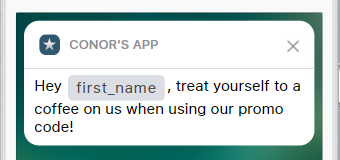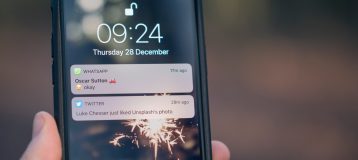Hi, my name is Finóla. Today I’m going to teach you how to write effective, engaging, creative copy for your push and in-app notification strategy. I’m going to do this by showing you some examples of what does and doesn’t work and how you can improve on this. So let’s get into it.
Here’s a still of this week’s Academy whiteboard. Click on it to open a high resolution image in a new tab!
VIDEO TRANSCRIPTION | BEST PRACTICES SERIES
As we know, push notifications are a great way of re-engaging your app users, moving them down the funnel, bringing them back into your app. However, if you’re creating copy that is not relevant to each individual user and it’s not interesting, you could be driving your users away causing them to opt-out of push and also, even worse, deleting your app.
WHAT ARE THE TOP TIPS?
Let’s look at these top tips of how to create interesting copy and what you should do. Make sure you stay focused on adding value to your user. Be concise, keep them short and snappy and also build rapport, build that relationship with your users. Things to avoid. Avoid using all caps. It seems like you’re shouting at your users if you send a push notification in all caps and again, avoid jargon.
WHAT ARE THE DO’S AND DON’TS?
Some dos and don’ts. Be positive, not negative. Instead of saying things like don’t delay, you could say hurry,… don’t say forget, you could say remember and also there’s never been a better time, you could say now is the ideal time. Try and keep a positive and not use a negative language.
EXAMPLES OF GOOD PUSH NOTIFICATIONS
Looking at some examples of good push notifications that have been sent by brands before. The first one here is by a third-party airline ticketing app and they say, “London to New York, return January 10th to the 17th now $550, down $100, book now.” This is a great push notification. It’s engaging, it’s relevant. It’s clear that the user had been searching trips from London to New York before. They’ve now got a discount and it creates urgency and there’s a strong call to action there at the end saying book now.
The next one here is actually an example of a push notification that was used by one of our clients in the past. We have changed the name here today, but just to show this example because what they had originally done was just sent out a push notification saying, “use code S-H 10 and get 10% off today.” So they hadn’t personalized it and also they sent a mass push. They sent it out to everybody whether they were at home on their couch or over the other side of the country. What they did was they personalized it. They inserted the user’s first name at the beginning and they said you’re near the Spice House at 14 Camden Street. They made it a geotargeted message. They made sure that the users were in the area when they received this and then they could the 10% off code. There’s a great call to action there saying, “use the code S-H 10 and get 10% off today.” Again, it creates that urgency.
The last example here in the good examples of push notifications, they say, “let’s workout. You thought this was the perfect time a while back remember?” So this is an example from an exercise app and it has a strong call to action here at the beginning saying, “let’s workout” and they also create this almost guilt by saying remember this time suited you a while ago and you were doing it? You’re not doing it now. That’s a great case of a good, concise, to the point push notification that has been used before.
EXAMPLES OF POOR PUSH NOTIFICATIONS
As I said earlier, a poorly written, untimely push notification can be the perfect excuse for your app users to opt-out. So let’s take a look at these bad examples. The first one here states “sale starts now.” This was sent by a discount department store who firstly have sales on all the time, so it was nothing unique to them and also they sent it as a mass push. They could have segmented their users, meaning that males would have got certain notifications based on categories that they had looked at in their app before and females got other ones, maybe people who had looked in the home department get other push notifications. So segmenting your audience is really important and half the battle to having a postive, strong push notification strategy.
The second here says, “Breaking news. Twenty thousand students are still waiting for their grants to be processed.” Breaking news from news apps comes quite often and if it’s not actually a breaking news story, it’s not good practice to say it because your app users are just going to stop paying attention when they know that it’s not a very important story. The third one here just says, Please log your sleep data.” Firstly, it’s not interesting, it’s not engaging and they use the word “please” at the beginning. So it sounds like they’re begging their app users to do something, which isn’t good.
Now just taking a look here at some call to actions that you can use to create a good push notification. It’s really important to include a call to action in each push so that you’re telling your users what they need to do next. Take a look there yourselves, just watch, take, talk, join, find, save, shop. These are all good examples of strong call to actions that you can use.
WHAT IS THE MOST IMPORTANT QUALITY TO REMEMBER?
The most important quality to remember when messaging your users is empathy. You need to put yourself in their shoes and think about how interesting the message is and if it’s relevant to them and also would you want to receive the message, yourself. You also need to listen to the actions your users are taking. So are they opting-out of push? Maybe you need to re-think your strategy then and also have a look at your copy and take some of the tips there on board about staying focused and being concise. That’s it for me here today. Be sure to subscribe, if you haven’t done so already. Leave a comment below and also follow us on Twitter @PulsateHQ. See you next time.






HAVE YOUR SAY. LEAVE A COMMENT